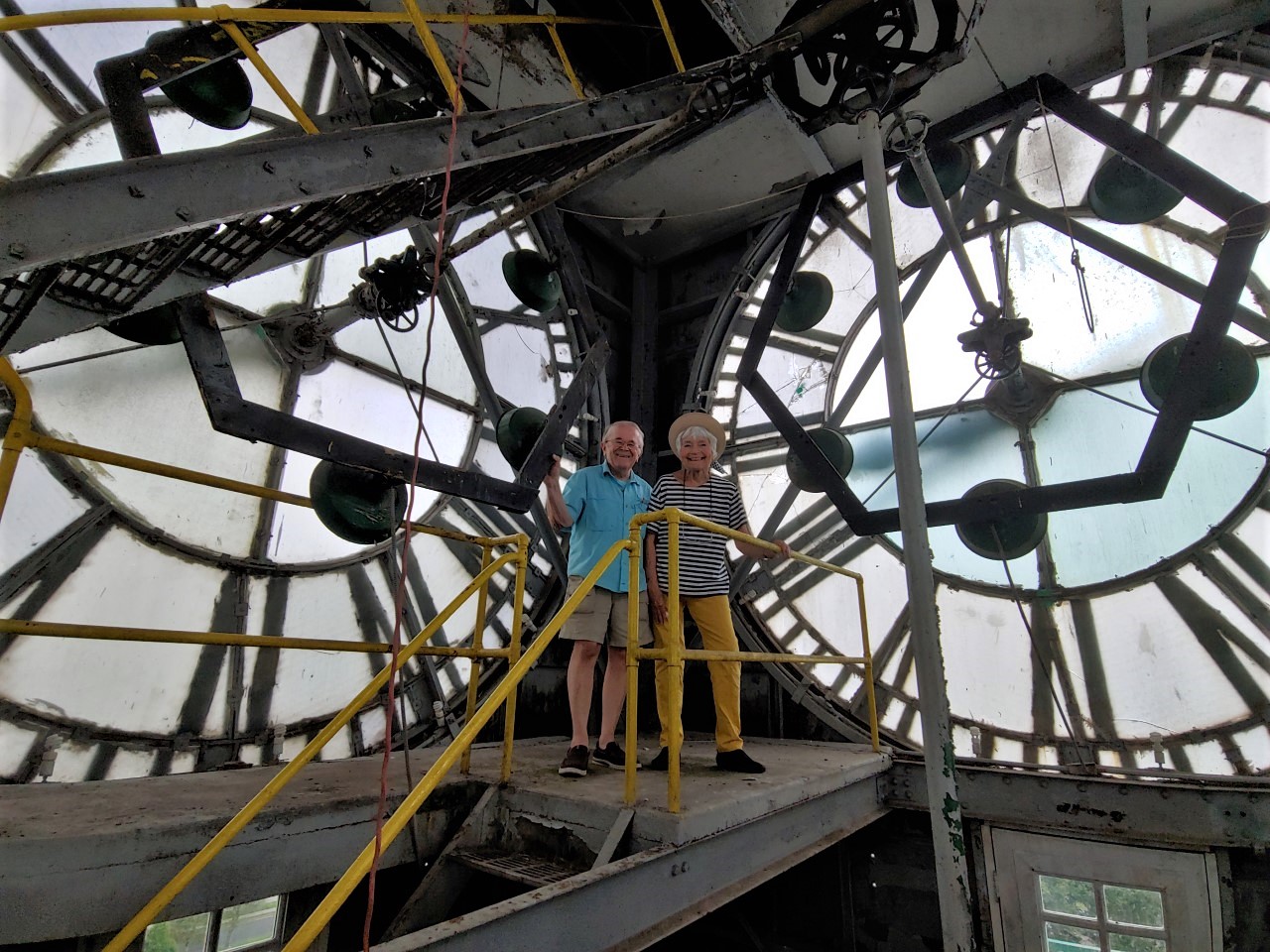History comes alive on 99 steps to the top of a Bucks County icon.
I’ve always enjoyed climbing things to view the world from a different perspective. That began as a kid whenever we visited my grandparents. My first instinct was to climb “grandma’s mountain” to enjoy the view of San Francisco Bay, ocean freighters heading for the Golden Gate Bridge and planes buzzing around below me.
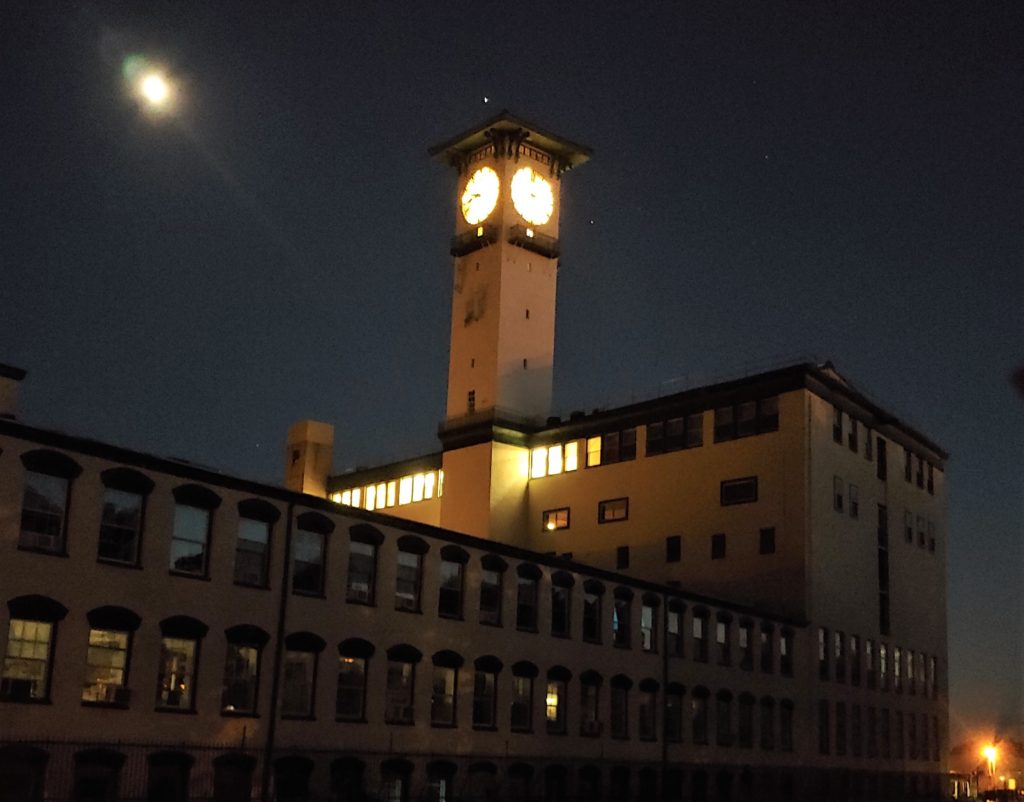
Years ago in Bucks County, my eye caught sight of the Grundy Clock Tower looming 186 feet above the leafy streets of Bristol. “Bristol on the Delaware”, as Frederic Baumgarten likes to call the 338-year-old borough. Recently my adventure buddy Wynne Wert and I got the chance to climb the tower after meeting Fred. He owns it. Not only that. The Manhattan native is one of the visionaries behind ongoing borough rejuvenation. “I believe in Bristol,” he told us.. “Bristol is small-town America where young people come to raise a family. You have a community here, not suburbia where everything is so bland.”
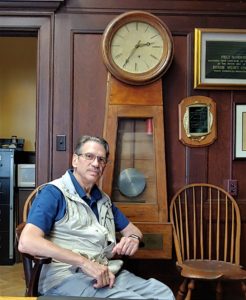
In 1910 U.S. Senator Joe Grundy, Bristol’s homegrown benefactor, built the four-faced clock tower and 7-story textile warehouse attached to it. Today they’re part of the historic Grundy Mills Complex founded by Joe’s Quaker father William in 1880. The mills sit beside the southern terminus of the Delaware Canal. With business flourishing in the 1920s, Senator Grundy employed 850 workers at the mills, the largest employer in Bucks. The factories produced some of the finest worsted woolen fabrics in the world.
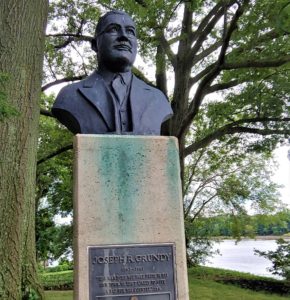
Grundy was so proud he built the clock tower as a symbol of borough prosperity. No one could miss seeing it on passing trains on the nearby New York-Philadelphia rail line. When the textile industry in the U.S. began its long decline in the 1940s, the mills closed and were sold. Things only got worse until Fred bought the complex in 1981 and renamed it “Grundy Commons”. Since then, he’s invested a substantial amount of money and effort into giving the tower a facelift and refurbishing 300,000 square feet of floor space in the warehouse and mills, 90 percent leased. The Delaware Riverkeeper Network, Advent Design, Dad’s Hat rye distillery, Stepping Stone Dance Studio, Witherspoon Boxing and 20 other tenants occupy the space. Just competed is the final 20,000 square feet of warehouse floor space for a future tenant.
Workers recently re-tiled the terra cotta roof of the tower, one of the tallest structures in Bucks. Its white metal sheathing and decorative cornices beneath the roof give it a Florentine Old World visage. Access begins on the 7th floor of the warehouse where an interior stairwell ascends. Wynne and I held tightly to handrails fashioned from iron piping. Ninety-nine metal steps offered a thrilling view below as we moved higher. Fred stepped boldly while explaining what we were seeing. Near the top, we came to a dimly lit compartment where large gears turn ornamental balsa wood hands of the clocks. The clockwork is powered by a tiny electric motor about as big as your hand.
One more flight of stairs to go. Up we went, emerging onto a brilliantly lit cement landing. All four clock faces of half-inch glass encircled us from above, each 14 feet in diameter with hours noted in black Roman numerals. Legacy clockmaker Seth Thomas of Connecticut manufactured the timepieces for Senator Grundy.
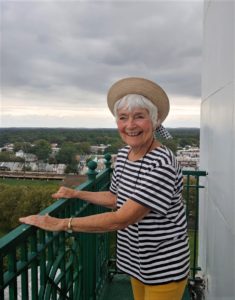
Beneath each of the clocks is a door opening to an iron balcony. There the panorama of Bucks County’s greenery is a mid-summer dream – south to Philly’s skyline, west to misty Haycock Mountain in Upper Bucks, north to the canal waterway, and east to Bristol’s neighborhoods and the Delaware River. We stood on the north balcony looking down on miniaturized figures of local residents enjoying the town’s landscaped canal lagoon and water fountain. One hundred years ago boatmen heading south from Easton with upstate coal knew they were near the end of their 60-mile journey on seeing the clock tower. Fred and I imagined that might have been where the canal turns south in Morrisville 12 miles to the north.
Wynne, on the balcony overlooking Bristol, smiled broadly at the wonder of being atop such an icon and wondered if mill workers in olden times had the opportunity to stand on the same balcony “to view their town, their house or school.” From our vantage point, Fred has accomplished a beautiful restoration of the mills. After refurbishing the clock tower exterior in 1986, he addressed local folks. “I felt a responsibility to restore it,” he said. “I got caught up in the excitement that was beginning to sweep Bristol. I wanted to do my fair share. This rededication is not just to honor our past as it is a stepping stone for Bristol’s future.”
Sources include research by Grundy Library archivists Harold and Carol Michener, and an article by Eliza Newlin on the rededication of the clock tower published on Sept. 17, 1986 in the Bucks County Courier Times.

